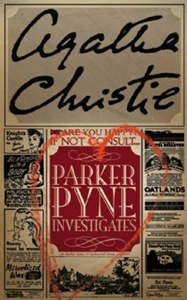Like “The Mysterious Mr. Quin,” “Parker Pyne Investigates” (1934) is a one-off collection of episodic short stories that launches a new and unusual investigator. The book is also known as “Mr. Parker Pyne, Detective,” but he’s not a detective. Agatha Christie herself struggles to come up with the right word for him, but I’ll take a crack at it: He’s like a life coach, except you pay by the specific situation rather than keeping him on full-time.
Analyst ahead of his time
Pyne believes in analytics almost a century before they are popularized. He can predict human behavior based on statistical data and observation. Although he shares the latter trait with Poirot and Marple, Pyne generally doesn’t solve crimes, he solves people’s unhappiness.
Christie’s fascination with human behavior is channeled through Pyne – mostly in entertaining fashion, after a couple bland stories establish how his practice operates. The author has a strong grasp of the nature of attraction between men and women.

“Parker Pyne Investigates” (1934)
Also published as: “Mr. Parker Pyne, Detective”
Author: Agatha Christie
Genre: Mystery short stories
Settings: England, Middle East, 1930s
For example, Pyne knows that women are not attracted to men who worship them. That’s too easy; they enjoy the process of reforming a man. So although it seems disingenuous at first blush, they prefer men who have eyes for, and the attentions of, other women.
On the flip side, well, what attracts men is easier to figure out. “The Case of the Discontented Husband” plays this out to its amusing conclusion when client Reggie becomes obsessed with Pyne’s disguise artist Madeleine, whose role is to make Reggie’s wife jealous.
Accidental detective
In later stories, Pyne is on vacation in the Middle East (the “Orient” in Christie terminology) and accidentally plays the role of detective. I thought maybe the “Mr. Parker Pyne, Detective” title would click at the end where he decides he’ll be a professional private detective, but that’s not strictly the case.
A particularly noteworthy title from later in the book is “Death on the Nile,” because the same title would adorn a famous Poirot novel a few years later. It’s not the same plot, but it is a classic question of what family member murdered the woman on the cruise ship who managed to annoy everyone.
The quality of the “Parker Pyne Investigates” yarns – whether a murder mystery or a case of Pyne and his team nudging people to create a happy outcome for the client – is fairly high throughout. The book doesn’t have the effortless greatness of Marple’s “The Tuesday Club Murders,” but it finds its purpose more smoothly than the likewise experimental “The Mysterious Mr. Quin” (with its almost supernatural title character) and “Partners in Crime” (featuring Tommy and Tuppence play-acting their way into detective work).

Pyne himself isn’t fully characterized, which is mostly on purpose. I pictured him as a suave middle-aged guy early in the book, but later Christie describes him as older and retired from his original career as a government worker, so I guess he’s close to Poirot’s age. As with most of Christie’s short stories, these first appeared in magazines, so perhaps her image of Pyne took a while to coalesce.
I see that Pyne will pop up later in a couple more short stories, which I look forward to reading. But generally Pyne didn’t take off as a popular character. I don’t know if Christie hoped to do more with him. I’m guessing she felt his ideal format was short stories centered on a singular sharp observance of human behavior.
Every week, Sleuthing Sunday reviews an Agatha Christie book or adaptation. Click here to visit our Agatha Christie Zone.

